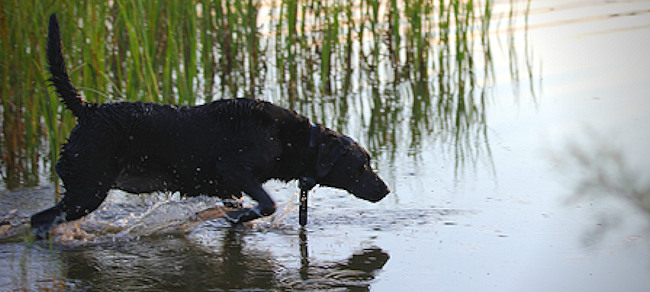“Our added winter moisture and active calling period led to a very long nesting and hatching season, starting in late April and extending into early summer, with chicks hatching as late as early July,” O’Dell said. “From a population standpoint, we are out of a deficit for the first time since 2001-2002. Quail are starting to pop up in places they haven’t been seen in a while.
“If you’ve never had the chance to experience what Arizona quail hunting built its name on, then this would be the year to get out and enjoy it.”
Meanwhile, hunters should note that the season for Mearns’ quail doesn’t begin until Dec. 4. It’s summer rainfall that plays a key role in nesting success and population numbers of this species. After a spotty and relatively weak monsoon across southern Arizona, these birds are likely to be abundant only in pockets that received sufficient precipitation this summer.
A valid Arizona hunting or combination hunt and fish license is required for all hunters 10 and older. Those hunters under 10 must either have a valid hunting or combination hunt and fish license, or be accompanied by an adult who possesses a valid hunting or combination hunt and fish license. Licenses can be purchased online or at license dealers statewide. A youth combination hunt and fish license (ages 10 to 17) is $5.
The general bag limit is 15 quail per day in the aggregate, of which no more than eight may be Mearns’ quail (when the Mearns’ season opens Dec. 4). The general possession limit is 45 quail in the aggregate after opening day, of which no more than 15 Gambel’s, scaled or California quail in the aggregate may be taken in any one day. After the opening of the Mearns’ season, the 45-quail possession limit may include 24 Mearns’ quail, of which no more than eight may be taken in any one day.
More quail-hunting information can be found on the department’s website at https://www.azgfd.com/Hunting/. Another resource for both new and experienced hunters alike is “An Introduction to Hunting Arizona’s Small Game.” Written by Randall D. Babb, the 196-page, full-color book covers where and how to hunt small game birds (like quail), squirrels, rabbits, ducks and geese. It also includes how to prepare and cook your harvest, with illustrations and recipes. The book can be ordered for $16.95 at www.azgfd.gov/publications.
Finally, hunters should check out O’Dell’s techniques for field-dressing quail at https://www.youtube.com/watch?v=3gRwZAcWzzk.
####
Publishers Notes: OUT OF STATE HUNTERS, FISHERMEN & OUTDOOR ENTHUSIASTS; Due to the Covid 19 pandemic, there could be limitations for OUT of STATE hunters, fishermen and other outdoor enthusiasts to include a 14-day quarantine requirement or negative COVID-19 testing alternative. Please check with the State's Department of Natural Resources BEFORE you travel or apply for the 2020 Fall Hunts.
The Backcountry Press
The country's premier daily HUNTING, FISHING & OUTDOOR news in the USA and around the globe. Read whats happening in your neck of the woods & beyond.
The Backcountry Outdoor News reports the latest hunting and, fishing news along with fishing derbies and tournaments
from:
| ||||||
| ||||||
|
HUNTING NEWS CATEGORIES
© 2010 Backcountry Press Outdoor News - All Rights Reserved Website Design by:
Connect With Us
 | ||||
Disclaimer: The views expressed on this site are that of the authors and not necessarily that of TBC Press
 | ||||
Kansas Hunting Dog Owners Cautioned To Watch for Harmful Algal Blooms
Submitted by: TBC Press
Posted on: 11/16/20
Kansas hunters are urged to remain vigilant to the dangers harmful algal blooms can pose to hunting dogs. Every summer, dogs in Kansas get sick or die from exposure to harmful blue-green algae, but potentially deadly algal blooms can still occur into fall and winter.
“There are a lot of different species (of blue-green algae) and some don’t care what season it is,” said Tom Stiles, Kansas Department of Health and Environment (KDHE) Bureau of Water director. “If there’s a period of sunshine, calm conditions and it’s warm, a bloom could pop up. Hunters need to pay attention to their dogs.”
KDHE monitors blue-green algae across the state April 1-Oct. 31. But Stiles knows heavy blooms have been documented well into November and believes they happen through the winter. Stiles added that 2020 has been a particularly bad year, with potentially harmful densities of blue-green algae reported at as many as 39 bodies of public water.
Algal blooms are often highly visible, appearing like a bright green slime on the water’s surface, though Stiles added the blooms come in other colors and textures. Hunters need to keep a watchful eye on water conditions before sending their dogs to make a retrieve. However, dogs have also ingested potentially fatal amounts of bacteria from water that showed no visible signs of the algae, so hunters are encouraged to err on the side of caution when hunting around waters documented to have had harmful algal blooms earlier in the year.
As well as directly drinking toxic water, Stiles said dogs often ingest the algae by eating it along the shoreline. Another common scenario is when a dog licks itself after coming out of toxic water.
Stiles said while algal blooms in Kansas’ large reservoirs get most of the attention, small waters on private lands can be just as dangerous. The state has thousands of small ponds that drain fertilized croplands, creating the potential for algal blooms.
“I get calls every year from ranchers who’ve lost cattle by a pond,” said Stiles. “If it’ll kill cattle, it’ll easily kill dogs.”
Stiles recommends hunters offer fresh drinking water often to their dogs to decrease their interest in drinking from tainted ponds or lakes. Dogs that have swam through possible blooms should be toweled off immediately and taken to a place where they can be sprayed thoroughly with clean water. Hunters also need to monitor their dog’s condition for hours following a hunt.
“Sometimes it’s only a matter of minutes before they get really sick but other times it’s hours,” said Stiles. “If a dog is exhibiting any symptoms like throwing up, is especially lethargic or starts having seizures, rush it to the vet.”
If you suspect that your dog got sick because of exposure to blue-green algae, please report it to the KDHE by calling the EpiHotline (877-427-7317) or by using this online form found at: https://kdheks.co1.qualtrics.com/jfe/form/SV_3m9Zfcls27nckMB.
For more information on blue-green algal blooms in Kansas, visit www.kdheks.gov/algae-illness.
Image courtesy of KDWPT
####
Publishers Notes: OUT OF STATE HUNTERS, FISHERMEN & OUTDOOR ENTHUSIASTS; Due to the Covid 19 pandemic, there could be limitations for OUT of STATE hunters, fishermen and other outdoor enthusiasts to include a 14-day quarantine requirement or negative COVID-19 testing alternative. Please check with the State's Department of Natural Resources BEFORE you travel or apply for the 2020 Fall Hunts.
Our country is still battling COVID-19. To avoid the spread of this virus and continue to enjoy outdoor activities, ALL outdoor enthusiasts (man, woman, child) should follow the guidelines set by nps.gov. These guidelines include; social distancing, the Leave No Trace principles, including pack-in and pack-out, to keep outdoor spaces safe and healthy.
News # 14083














